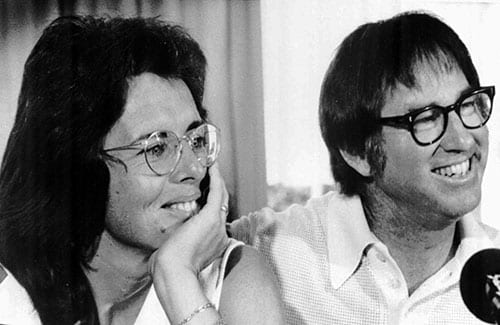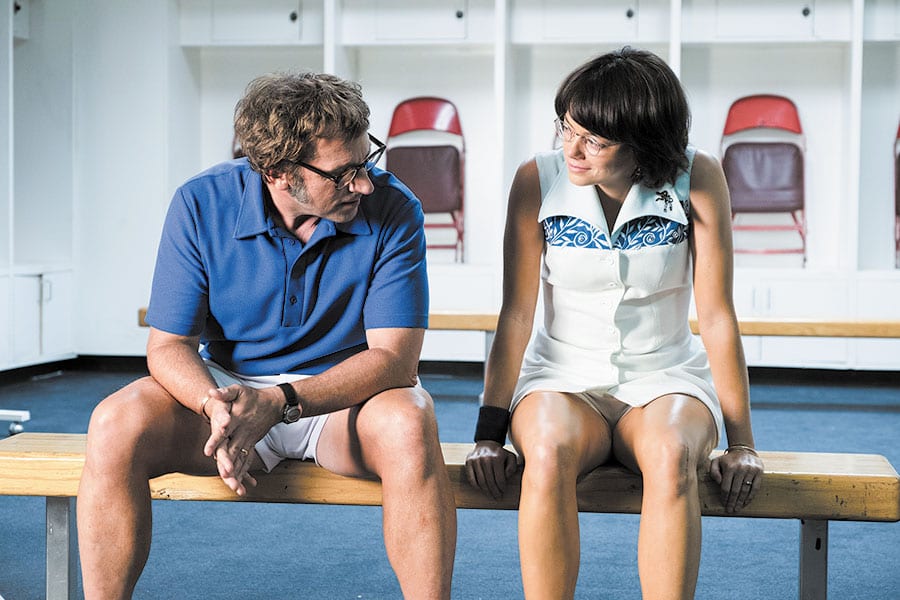Andrea Riseborough and Emma Stone
The match between Billie Jean King and Bobby Riggs (44 years ago this month) was about more than tennis — it was a fight for equality
LAWRENCE FERBER | Contributing Writer
lawrenceferber@gmail.com
There’s a scene near the end of 1970s-set Battle of the Sexes in which gay fashion designer Cuthbert Collingwood “Ted” Tinling tells closeted tennis champ Billie Jean King that the times will change and, eventually, queers shall live and love openly: after all, she is one of the people changing them.
How prescient Tinling was.
Directed by the wife and husband team of Valerie Faris and Jonathan Dayton (Little Miss Sunshine) and scripted by Simon Beaufoy (The Full Monty, Slumdog Millionaire), the new film Battle of the Sexes (now playing in North Texas; see review, Page 23) revisits the earth-moving 1973 tennis match between twenty-something King (Emma Stone) and fifty-something Bobby Riggs (Steve Carell), a former men’s champ turned showboating chauvinist and hustler. It takes place as the married and deeply closeted King experiences a first lesbian love with a Los Angeles hairdresser, Marilyn Barnett (Andrea Riseborough). The match would ultimately score a major point for gender equality in the sport, while King would go on to become an out icon.
“It’s a sports movie, but frankly what got us interested in this was to tell Billie Jean’s personal story,” says Dayton. “The thing people hadn’t heard before.”
Indeed, the film tackles King’s profound realization that she is other than straight, her tortured and complicated love triangle with Marilyn and husband Larry King (Austin Stowell), the endless stinkeye she received from virulently homophobic Aussie tennis rival Margaret Court (Jessica McNamee) and King’s passionate efforts to bring gender equality to society and her sport. The film actually commences with a 1970 rift between the time’s dominant male-run U.S. Lawn Tennis Association, under which women received a mere fraction of the prize money male players did at tournaments. King subsequently formed the Virginia Slims Circuit with eight other women, later dubbed the “Original 9,” and World Tennis Magazine publisher Gladys Hellman (Sarah Silverman), which became the Women’s Tennis Association (WTA) Tour by 1973.
King was involved with the film’s creation from early on — an extensive session with Beaufoy during the scripting stage, reading subsequent drafts, viewing early cuts — and weighed in throughout. “She was very involved, and it was difficult for her, because this was a really hard time in her life, and she hasn’t really revisited it,” says Dayton. “She said she hadn’t seen the match in 25 years, and the relationship with Marilyn was fraught.”
Indeed, the relationship with Barnett, who was known professionally as King’s “assistant,” has been characterized by many as toxic and completely deteriorated in the subsequent years. It served as catalyst for King coming out publicly in 1981, when Burnett filed a palimony suit that claimed she was owed a Malibu home and lifetime financial support. The resulting publicity saw King lose all endorsements overnight and incur devastating legal fees. King, still married to Larry at the time, characterized Barnett as mentally unstable — a paraplegic due to an accident by this time, she reportedly attempted suicide by jumping off a building — and King ultimately won the case. Today, King is happily partnered with Ilana Kloss, a fellow former tennis champ and current commissioner of co-ed tennis league, WTT.
Despite the unfortunate way things turned out for the relationship and Barnett, the filmmakers focused on the sunniness of their early days together, “because it was a key moment for Billie Jean, and we wanted to celebrate her finding her authentic self and not get locked up in what happens later,” says Dayton. “We’re really telling the story of this particular time in her life. And now that it’s finished and she can watch the movie with an audience, I think it’s been an incredibly positive thing for her.”
English actress Riseborough, who previously co-starred with Stone in 2014’s Birdman (her credits also include Tom Ford’s Nocturnal Animals and Madonna’s W.E.), admits she tried to focus on the Marilyn of those happier early days, and keep what followed on the periphery.
“None of us know where our lives will be in 10 years no matter how we plan or imagine things,” she says. “We have no idea what facets of our personalities might come out. The relationship with Marilyn awakened something in Billie Jean. That was a huge basis for how I played her. Freedom and liberty and the hope of the early ’70s, she embodies all of that in our film. I felt she was incredibly grounded and earthy, but she had lightness, was ethereal and hopeful, and free-spirited. Apparently, Marilyn had those qualities, Billie Jean told me.”
In constructing the film, the makers took significant artistic license with the timeline of real events, especially in regards to the relationships depicted (including that of Riggs and wife Priscilla, played by Elisabeth Shue), for emotional resonance. To play King, Stone trained extensively in tennis for four months, gaining 15 pounds of muscle in the process, while extensively researching and spending face time with the icon. Yet although newly-minted Oscar winner Stone imbued her performance with subtle King-isms — the pitch of her voice, body language, gait, and smile — Dayton and Faris elected not to go the Monster route of extensive makeup and hair work to fully transform Stone into the freckled face and, as Faris diplomatically puts it, “less stylish haircuts” of King at the time. “We made a creative decision to avoid the mullet,” says Dayton.
“I think to get that mullet we would have had to put so much hair on Emma,” Faris elaborates, “and deal with the logistics of wigs and prosthetics. It’s not so much about making her look like Billie Jean exactly.”

Billie Jean King and Bobby Riggs
Riseborough also had the opportunity to spend personal time with King, although not until after production wrapped. She admits that having King’s personal support for the production was important to all involved and found her to be a profoundly inspirational figure. “You spend five minutes around her and you want to go into your life and start punching walls, she’s so motivating,” Riseborough says. “Billie said that I was eerily like Marilyn. I’m very pleased with that.”
For the gripping climactic match, shot to evoke 1970s sports TV, pro players Kaitlyn Christian and Vince Spadea doubled for Cavell and Stone, recreating their respective characters’ playing styles (from the size, shape and weight of racquets to tennis court surfaces — everything about the game has changed since then). Christian also stood in for Stone during a recreation of King’s tense match with Court (Lauren Kline doubled for McNamee during this scene).
Court, who segued from her tennis career to that of Pentecostal minister, has been actively rallying against same-sex marriage in Australia — a non-binding survey of the country’s population on whether same-sex marriage should be legal is underway and could motivate politicians to actually move ahead with legislation — and made international press recently for her proclamation that gays “want marriage because they want to destroy it” and somehow that will lead to eradication of Mother’s Day, Father’s Day, Easter and Christmas to boot. (Ironic, in part, because Court’s disastrous match where Riggs trounced her four months prior to King’s was nicknamed the Mother’s Day Massacre.)
“We were a little worried that we were going too far with portraying her homophobia,” Dayton says, “but she’s been very good at making us feel comfortable that we haven’t exaggerated anything.”
One supporting character whose life absolutely reads stranger than fiction — and easily deserves his own film — is Tinling, the Original 9’s dress designer (he also designed Martina Navratilova’s 1979 Wimbledon dress), also served as a British spy during WWII, as a pro tennis player, as a tennis historian/commentator and author during his 79 years (he died in 1990). Alan Cumming plays Tinling as friend and sort of queer mentor to King, and delivers one of the most memorable, moving lines at the end.
“We just scratched the surface [with him]!” Dayton says. “There were so many interesting people [within this story] and they all deserved more time, but that was part of the fun of this — to throw them all together and keep all these balls in the air as we tell this particular story.”
•••••••••••••••••••••••••••••••••••••••••••••••••••••••••••••••••••

QUEER CLIP: ‘Battle of the Sexes’
If you’re not old enough to remember women’s lib, male chauvinist pigs and the Equal Rights Amendment, then gather ’round the campfire, my children — you’re about to get schooled.
You might have thought that women’s rights were nothing more than the Lilly Ledbetter Act and pop-culture conversations about a mythic glass ceiling, but in the 1970s it was more hotly debated than presidential tweets and Confederate monuments are today, and it couldn’t hide in naval-gazing algorithms on your social media of choice. Despite the passage of Title IX in 1972, as of 1973 (and, ya know, today) women in sports were treated as second-class citizens. And that was nowhere more apparent than in tennis. Despite marquee names, women were paid a tiny fraction of men’s purses (tee-hee… men had purses), and it took Billie Jean King (Emma Stone), the sport’s leading female, to shake things up. She formed a rival tour to the male-favoring USLTA, which came to be called the Virginia Slims, and made a case for respect — not, as closed-minded males insisted, because women “wanted to become men,” but because women deserved to be treated as different but equal. “Is your mom less a person than your dad?” she bites at one heckler.
But chauvinists had their leaders, too, among them a past-his-prime former Wimbledon champ named Bobby Riggs (Steve Carell), who’d settled into a niche as a clownish hustler, more professional wrestler than pro athlete. And he wanted to increase his brand by sowing discord among the sexes: Who was better, men or women? He certainly
believed it at some level, but he was more
conman than strongman… like a certain Oval Office resident of today.
Battle of the Sexes is probably the best “gay” movie that doesn’t get ghetto-ized into being a “gay” movie like most of them do. It transcends that easy moniker — heck, they should have called it Brokebackhand Mountain. Because while King is taking a stand for equality, she’s also exploring her taboo feelings for her hairdresser Marilyn (Andrea Riseborough) while still married to her good-guy hubby. And so we get these parallel courses: Coming out, both as feminist and gay… though one would be more accepted back then than the other.
The film is endlessly fascinating as directors Valerie Faris and Jonathan Dayton and screenwriter Simon Beaufoy juggle sex and sexual, struggle vs. struggle, painting sympathetic portraits of damn near everyone (except the virulently homophobic Margaret Court and the bigoted tennis promoter Jack Kramer, played to a hateable T by Bill Pullman). Still, other than King — a transformative performance by Stone, which will certainly net her another Oscar nom — it’s Alan Cumming in a peripheral role as an out man within her orbit who becomes something of the touchstone of the piece. He represents the struggle and the hope of making a difference. And in light of last year’s election results and the presence of a showboater-in-chief (and Carell is a master at it), it’s difficult not to draw current-day similarities between what’s onscreen and real life. Game, set and match to progressives… no matter how long it takes.
— Arnold Wayne Jones
Five stars. Now playing.
This article appeared in the Dallas Voice print edition September 29, 2017.

